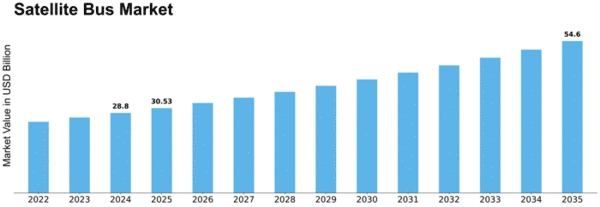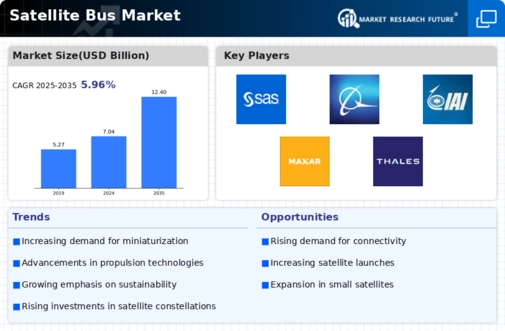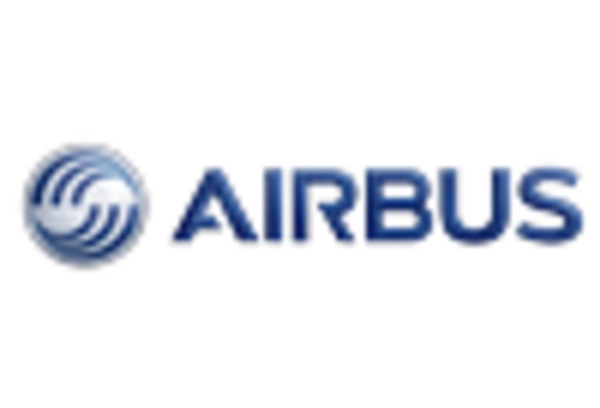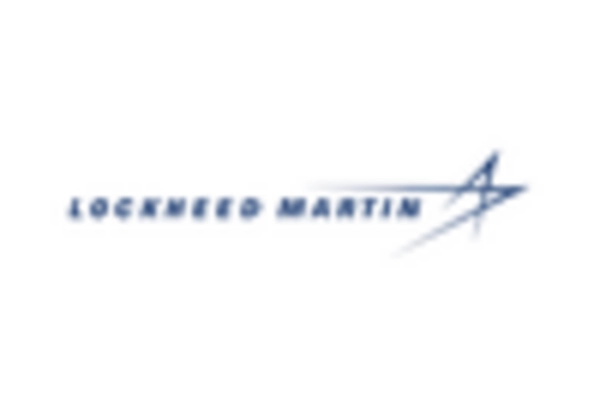-
EXECUTIVE SUMMARY
-
MARKET ATTRACTIVENESS ANALYSIS
- GLOBAL SATELLITE BUS MARKET, BY SATELLITE TYPE
- GLOBAL SATELLITE BUS MARKET, BY SUBSYSTEM
- GLOBAL SATELLITE BUS MARKET, BY APPLICATION
- GLOBAL SATELLITE BUS MARKET, BY REGION
-
MARKET INTRODUCTION
-
DEFINITION
-
SCOPE OF THE STUDY
-
RESEARCH OBJECTIVE
-
MARKET STRUCTURE
-
KEY BUYING CRITERIA
-
RESEARCH METHODOLOGY
-
RESEARCH PROCESS
-
PRIMARY RESEARCH
-
SECONDARY RESEARCH
-
MARKET SIZE ESTIMATION
-
FORECAST MODEL
-
LIST OF ASSUMPTIONS
-
MARKET INSIGHTS
-
IMPACT OF COVID-19
-
IMPACT OF COVID-19 ON THE GLOBAL SATELLITE BUS MARKET
- IMPACT OF COVID-19 ON GLOBAL MARKET
-
IMPACT OF COVID-19 ON THE GLOBAL SATELLITE BUS MARKET
-
SUPPLY CHAIN IMPACT
- IMPACT ON MANUFACTURER/DEVELOPER
- IMPACT ON COMPONENT SUPPLIER
- IMPACT ON DISTRIBUTION/LOGISTICS
- IMPACT ON CONSUMER
-
MARKET RECOVERY ANALYSIS
-
MARKET DYNAMICS
-
INTRODUCTION
-
DRIVERS
- INCREASING DEPLOYMENT OF SMALL SATELLITES
- INCREASE IN DEMAND FOR SPACE DATA
- INCREASING DEMAND FOR EARTH OBSERVATION IMAGERY AND ANALYTICS
- DRIVERS IMPACT ANALYSIS
-
RESTRAINTS
- LACK OF CLARITY IN GOVERNMENT POLICIES
- HIGH COST OF DEVELOPMENT AND MANUFACTURING
- RESTRAINTS IMPACT ANALYSIS
-
OPPORTUNITIES
- INCREASING GOVERNMENT INVESTMENTS IN SPACE TECHNOLOGY
-
TECHNOLOGICAL TRENDS
- INTERNET OF THINGS (IOT)
- ARTIFICIAL INTELLIGENCE (AI)
- BIG DATA ANALYTICS
-
PATENT ANALYSIS
-
REGULATORY LANDSCAPE/STANDARDS
- IADC SPACE DEBRIS MITIGATION GUIDELINES; COPUOS SPACE DEBRIS GUIDELINES
- UNITED NATIONS OFFICE FOR OUTER SPACE AFFAIRS
- ITU RADIO REGULATIONS
-
MARKET FACTOR ANALYSIS
-
SUPPLY CHAIN
- DESIGN & DEVELOPMENT
- SYSTEM/COMPONENT SUPPLY
- SYSTEM INTEGRATION
- END USE
-
PORTER'S FIVE FORCES MODEL
- THREAT OF NEW ENTRANTS
- BARGAINING POWER OF SUPPLIERS
- BARGAINING POWER OF BUYERS
- THREAT OF SUBSTITUTES
- INTENSITY OF RIVALRY
-
GLOBAL SATELLITE BUS MARKET, BY SATELLITE TYPE
-
OVERVIEW
-
SMALL SATELLITE
-
MEDIUM SATELLITE
-
LARGE SATELLITE
-
GLOBAL SATELLITE BUS MARKET, BY SATELLITE TYPE, 2021–2030 (USD MILLION)
-
GLOBAL SATELLITE BUS MARKET, BY SUBSYSTEM
-
OVERVIEW
-
ELECTRIC POWER SYSTEM (EPS)
-
THERMAL CONTROL
-
ATTITUDE CONTROL SYSTEM
-
FLIGHT SOFTWARE
-
TELEMETRY TRACKING AND COMMAND (TT&C)
-
OTHERS
-
GLOBAL SATELLITE BUS MARKET, BY SUBSYSTEM, 2021–2030 (USD MILLION)
-
GLOBAL SATELLITE BUS MARKET, BY APPLICATION
-
OVERVIEW
-
EARTH OBSERVATION & METEOROLOGY
-
SCIENTIFIC RESEARCH & EXPLORATION
-
MAPPING & NAVIGATION
-
COMMUNICATION
-
SURVEILLANCE & SECURITY
-
GLOBAL SATELLITE BUS MARKET, BY APPLICATION, 2021–2030 (USD MILLION)
-
GLOBAL SATELLITE BUS MARKET, BY REGION
-
OVERVIEW
-
NORTH AMERICA
- NORTH AMERICA: SATELLITE BUS MARKET, BY COUNTRY, 2021–2030 (USD MILLION)
- NORTH AMERICA: SATELLITE BUS MARKET, BY SATELLITE TYPE, 2021–2030 (USD MILLION)
- NORTH AMERICA: SATELLITE BUS MARKET, BY SUBSYSTEM, 2021–2030 (USD MILLION)
- NORTH AMERICA: SATELLITE BUS MARKET, BY APPLICATION, 2021–2030 (USD MILLION)
- US
- US: SATELLITE BUS MARKET, BY SATELLITE TYPE, 2021–2030 (USD MILLION)
- US: SATELLITE BUS MARKET, BY SUBSYSTEM, 2021–2030 (USD MILLION)
- US: SATELLITE BUS MARKET, BY APPLICATION, 2021–2030 (USD MILLION)
- CANADA
- CANADA: SATELLITE BUS MARKET, BY SATELLITE TYPE, 2021–2030 (USD MILLION)
- CANADA: SATELLITE BUS MARKET, BY SUBSYSTEM, 2021–2030 (USD MILLION)
- CANADA: SATELLITE BUS MARKET, BY APPLICATION, 2021–2030 (USD MILLION)
-
EUROPE
- EUROPE: SATELLITE BUS MARKET, BY COUNTRY, 2021–2030 (USD MILLION)
- EUROPE: SATELLITE BUS MARKET, BY SATELLITE TYPE, 2021–2030 (USD MILLION)
- EUROPE: SATELLITE BUS MARKET, BY SUBSYSTEM, 2021–2030 (USD MILLION)
- EUROPE: SATELLITE BUS MARKET, BY APPLICATION, 2021–2030 (USD MILLION)
- UK
- UK: SATELLITE BUS MARKET, BY SATELLITE TYPE, 2021–2030 (USD MILLION)
- UK: SATELLITE BUS MARKET, BY SUBSYSTEM, 2021–2030 (USD MILLION)
- UK: SATELLITE BUS MARKET, BY APPLICATION, 2021–2030 (USD MILLION)
- GERMANY
- GERMANY: SATELLITE BUS MARKET, BY SATELLITE TYPE, 2021–2030 (USD MILLION)
- GERMANY: SATELLITE BUS MARKET, BY SUBSYSTEM, 2021–2030 (USD MILLION)
- GERMANY: SATELLITE BUS MARKET, BY APPLICATION, 2021–2030 (USD MILLION)
- FRANCE
- FRANCE: SATELLITE BUS MARKET, BY SATELLITE TYPE, 2021–2030 (USD MILLION)
- FRANCE: SATELLITE BUS MARKET, BY SUBSYSTEM, 2021–2030 (USD MILLION)
- FRANCE: SATELLITE BUS MARKET, BY APPLICATION, 2021–2030 (USD MILLION)
- ITALY
- ITALY: SATELLITE BUS MARKET, BY SATELLITE TYPE, 2021–2030 (USD MILLION)
- ITALY: SATELLITE BUS MARKET, BY SUBSYSTEM, 2021–2030 (USD MILLION)
- ITALY: SATELLITE BUS MARKET, BY APPLICATION, 2021–2030 (USD MILLION)
- REST OF EUROPE
- REST OF EUROPE: SATELLITE BUS MARKET, BY SATELLITE TYPE, 2021–2030 (USD MILLION)
- REST OF EUROPE: SATELLITE BUS MARKET, BY SUBSYSTEM, 2021–2030 (USD MILLION)
- REST OF EUROPE: SATELLITE BUS MARKET, BY APPLICATION, 2021–2030 (USD MILLION)
-
ASIA-PACIFIC
- ASIA-PACIFIC: SATELLITE BUS MARKET, BY COUNTRY, 2021–2030 (USD MILLION)
- ASIA-PACIFIC: SATELLITE BUS MARKET, BY SATELLITE TYPE, 2021–2030 (USD MILLION)
- ASIA-PACIFIC: SATELLITE BUS MARKET, BY SUBSYSTEM, 2021–2030 (USD MILLION)
- ASIA-PACIFIC: SATELLITE BUS MARKET, BY APPLICATION, 2021–2030 (USD MILLION)
- CHINA
- CHINA: SATELLITE BUS MARKET, BY SATELLITE TYPE, 2021–2030 (USD MILLION)
- CHINA: SATELLITE BUS MARKET, BY SUBSYSTEM, 2021–2030 (USD MILLION)
- CHINA: SATELLITE BUS MARKET, BY APPLICATION, 2021–2030 (USD MILLION)
- JAPAN
- JAPAN: SATELLITE BUS MARKET, BY SATELLITE TYPE, 2021–2030 (USD MILLION)
- JAPAN: SATELLITE BUS MARKET, BY SUBSYSTEM, 2021–2030 (USD MILLION)
- JAPAN: SATELLITE BUS MARKET, BY APPLICATION, 2021–2030 (USD MILLION)
- INDIA
- INDIA: SATELLITE BUS MARKET, BY SATELLITE TYPE, 2021–2030 (USD MILLION)
- INDIA: SATELLITE BUS MARKET, BY SUBSYSTEM, 2021–2030 (USD MILLION)
- INDIA: SATELLITE BUS MARKET, BY APPLICATION, 2021–2030 (USD MILLION)
- SOUTH KOREA
- SOUTH KOREA: SATELLITE BUS MARKET, BY SATELLITE TYPE, 2021–2030 (USD MILLION)
- SOUTH KOREA: SATELLITE BUS MARKET, BY SUBSYSTEM, 2021–2030 (USD MILLION)
- SOUTH KOREA: SATELLITE BUS MARKET, BY APPLICATION, 2021–2030 (USD MILLION)
- REST OF ASIA-PACIFIC
- REST OF ASIA-PACIFIC: SATELLITE BUS MARKET, BY SATELLITE TYPE, 2021–2030 (USD MILLION)
- REST OF ASIA-PACIFIC: SATELLITE BUS MARKET, BY SUBSYSTEM, 2021–2030 (USD MILLION)
- REST OF ASIA-PACIFIC: SATELLITE BUS MARKET, BY APPLICATION, 2021–2030 (USD MILLION)
-
MIDDLE EAST & AFRICA
- MIDDLE EAST & AFRICA: SATELLITE BUS MARKET, BY COUNTRY, 2021–2030 (USD MILLION)
- MIDDLE EAST & AFRICA: SATELLITE BUS MARKET, BY SATELLITE TYPE, 2021–2030 (USD MILLION)
- MIDDLE EAST & AFRICA: SATELLITE BUS MARKET, BY SUBSYSTEM, 2021–2030 (USD MILLION)
- MIDDLE EAST & AFRICA: SATELLITE BUS MARKET, BY APPLICATION, 2021–2030 (USD MILLION)
- SAUDI ARABIA
- SAUDI ARABIA: SATELLITE BUS MARKET, BY SATELLITE TYPE, 2021–2030 (USD MILLION)
- SAUDI ARABIA: SATELLITE BUS MARKET, BY SUBSYSTEM, 2021–2030 (USD MILLION)
- SAUDI ARABIA: SATELLITE BUS MARKET, BY APPLICATION, 2021–2030 (USD MILLION)
- UAE
- UAE: SATELLITE BUS MARKET, BY SATELLITE TYPE, 2021–2030 (USD MILLION)
- UAE: SATELLITE BUS MARKET, BY SUBSYSTEM, 2021–2030 (USD MILLION)
- UAE: SATELLITE BUS MARKET, BY APPLICATION, 2021–2030 (USD MILLION)
- TURKEY
- TURKEY: SATELLITE BUS MARKET, BY SATELLITE TYPE, 2021–2030 (USD MILLION)
- TURKEY: SATELLITE BUS MARKET, BY SUBSYSTEM, 2021–2030 (USD MILLION)
- TURKEY: SATELLITE BUS MARKET, BY APPLICATION, 2021–2030 (USD MILLION)
- REST OF MIDDLE EAST & AFRICA
- REST OF MIDDLE EAST & AFRICA: SATELLITE BUS MARKET, BY SATELLITE TYPE, 2021–2030 (USD MILLION)
- REST OF MIDDLE EAST & AFRICA: SATELLITE BUS MARKET, BY SUBSYSTEM, 2021–2030 (USD MILLION)
- REST OF MIDDLE EAST & AFRICA: SATELLITE BUS MARKET, BY APPLICATION, 2021–2030 (USD MILLION)
-
LATIN AMERICA
- LATIN AMERICA: SATELLITE BUS MARKET, BY COUNTRY, 2021–2030 (USD MILLION)
- LATIN AMERICA: SATELLITE BUS MARKET, BY SATELLITE TYPE, 2021–2030 (USD MILLION)
- LATIN AMERICA: SATELLITE BUS MARKET, BY SUBSYSTEM, 2021–2030 (USD MILLION)
- LATIN AMERICA: SATELLITE BUS MARKET, BY APPLICATION, 2021–2030 (USD MILLION)
- BRAZIL
- BRAZIL: SATELLITE BUS MARKET, BY SATELLITE TYPE, 2021–2030 (USD MILLION)
- BRAZIL: SATELLITE BUS MARKET, BY SUBSYSTEM, 2021–2030 (USD MILLION)
- BRAZIL: SATELLITE BUS MARKET, BY APPLICATION, 2021–2030 (USD MILLION)
- REST OF LATIN AMERICA
- REST OF LATIN AMERICA: SATELLITE BUS MARKET, BY SATELLITE TYPE, 2021–2030 (USD MILLION)
- REST OF LATIN AMERICA: SATELLITE BUS MARKET, BY SUBSYSTEM, 2021–2030 (USD MILLION)
- REST OF LATIN AMERICA: SATELLITE BUS MARKET, BY APPLICATION, 2021–2030 (USD MILLION)
-
COMPETITIVE LANDSCAPE
-
COMPETITIVE OVERVIEW
-
COMPETITIVE BENCHMARKING
-
MARKET SHARE ANALYSIS
-
MAJOR GROWTH STRATEGIES IN THE GLOBAL SATELLITE BUS MARKET
-
LEADING PLAYERS IN TERMS OF NUMBER OF DEVELOPMENTS IN THE GLOBAL SATELLITE BUS MARKET
-
KEY DEVELOPMENTS & GROWTH STRATEGIES
- CONTRACTS AND AGREEMENTS
- PRODUCT LAUNCHES/DEVELOPMENTS
- COLLABORATIONS/FUNDING/PARTNERSHIPS/ACQUISITIONS
-
COMPANY PROFILES
-
AIRBUS SAS
- COMPANY OVERVIEW
- FINANCIAL OVERVIEW
- PRODUCTS/SERVICES OFFERED
- KEY DEVELOPMENTS
- SWOT ANALYSIS
- KEY STRATEGIES
-
BALL CORPORATION
- COMPANY OVERVIEW
- FINANCIAL OVERVIEW
- PRODUCTS/SERVICES OFFERED
- KEY DEVELOPMENTS
- SWOT ANALYSIS
- KEY STRATEGIES
-
BOEING
- COMPANY OVERVIEW
- FINANCIAL OVERVIEW
- PRODUCTS/SERVICES OFFERED
- KEY DEVELOPMENTS
- SWOT ANALYSIS
- KEY STRATEGIES
-
CHINA AEROSPACE AND TECHNOLOGY CORPORATION
- COMPANY OVERVIEW
- FINANCIAL OVERVIEW
- PRODUCTS/SERVICES OFFERED
- KEY DEVELOPMENTS
- SWOT ANALYSIS
- KEY STRATEGIES
-
HONEYWELL INTERNATIONAL INC.
- COMPANY OVERVIEW
- FINANCIAL OVERVIEW
- PRODUCTS/SERVICES OFFERED
- KEY DEVELOPMENTS
- SWOT ANALYSIS
- KEY STRATEGIES
-
ISRAEL AEROSPACE INDUSTRIES
- COMPANY OVERVIEW
- FINANCIAL OVERVIEW
- PRODUCTS/SERVICES OFFERED
- KEY DEVELOPMENTS
- SWOT ANALYSIS
- KEY STRATEGIES
-
LOCKHEED MARTIN CORPORATION
- COMPANY OVERVIEW
- FINANCIAL OVERVIEW
- PRODUCTS/SERVICES OFFERED
- KEY DEVELOPMENTS
- SWOT ANALYSIS
- KEY STRATEGIES
-
MAXAR TECHNOLOGIES LTD
- COMPANY OVERVIEW
- FINANCIAL OVERVIEW
- PRODUCTS/SERVICES OFFERED
- KEY DEVELOPMENTS
- SWOT ANALYSIS
- KEY STRATEGIES
-
MITSUBISHI ELECTRIC CORPORATION
- COMPANY OVERVIEW
- FINANCIAL OVERVIEW
- PRODUCTS/SERVICES OFFERED
- KEY DEVELOPMENTS
- SWOT ANALYSIS
- KEY STRATEGIES
-
NORTHROP GRUMMAN CORPORATION
- COMPANY OVERVIEW
- FINANCIAL OVERVIEW
- PRODUCTS/SERVICES OFFERED
- KEY DEVELOPMENTS
- SWOT ANALYSIS
- KEY STRATEGIES
-
SIERRA NEVADA CORPORATION
- COMPANY OVERVIEW
- FINANCIAL OVERVIEW
- PRODUCTS/SERVICES OFFERED
- KEY DEVELOPMENTS
- SWOT ANALYSIS
- KEY STRATEGIES
-
THALES GROUP
- COMPANY OVERVIEW
- FINANCIAL OVERVIEW
- PRODUCTS/SERVICES OFFERED
- KEY DEVELOPMENTS
- SWOT ANALYSIS
- KEY STRATEGIES
-
APPENDIX
-
REFERENCES
-
List of Tables
-
PRIMARY INTERVIEWS
-
LIST OF ASSUMPTIONS
-
MAJOR GRANTED PATENTS ON SATELLITE BUS (1ST APRIL 2016 – 1ST APRIL 2021)
-
GLOBAL SATELLITE BUS MARKET, BY SATELLITE TYPE, 2021–2030 (USD MILLION)
-
GLOBAL SATELLITE BUS MARKET, BY SUBSYSTEM, 2021–2030 (USD MILLION)
-
GLOBAL SATELLITE BUS MARKET, BY APPLICATION, 2021–2030 (USD MILLION)
-
GLOBAL SATELLITE BUS MARKET, BY REGION, 2021–2030 (USD MILLION)
-
NORTH AMERICA: SATELLITE BUS MARKET, BY COUNTRY, 2021–2030 (USD MILLION)
-
NORTH AMERICA: SATELLITE BUS MARKET, BY SATELLITE TYPE, 2021–2030 (USD MILLION)
-
NORTH AMERICA: SATELLITE BUS MARKET, BY SUBSYSTEM, 2021–2030 (USD MILLION)
-
NORTH AMERICA: SATELLITE BUS MARKET, BY APPLICATION, 2021–2030 (USD MILLION)
-
US: SATELLITE BUS MARKET, BY SATELLITE TYPE, 2021–2030 (USD MILLION)
-
US: SATELLITE BUS MARKET, BY SUBSYSTEM, 2021–2030 (USD MILLION)
-
US: SATELLITE BUS MARKET, BY APPLICATION, 2021–2030 (USD MILLION)
-
CANADA: SATELLITE BUS MARKET, BY SATELLITE TYPE, 2021–2030 (USD MILLION)
-
CANADA: SATELLITE BUS MARKET, BY SUBSYSTEM, 2021–2030 (USD MILLION)
-
CANADA: SATELLITE BUS MARKET, BY APPLICATION, 2021–2030 (USD MILLION)
-
EUROPE: SATELLITE BUS MARKET, BY COUNTRY, 2021–2030 (USD MILLION)
-
EUROPE: SATELLITE BUS MARKET, BY SATELLITE TYPE, 2021–2030 (USD MILLION)
-
EUROPE: SATELLITE BUS MARKET, BY SUBSYSTEM, 2021–2030 (USD MILLION)
-
EUROPE: SATELLITE BUS MARKET, BY APPLICATION, 2021–2030 (USD MILLION)
-
UK: SATELLITE BUS MARKET, BY SATELLITE TYPE, 2021–2030 (USD MILLION)
-
UK: SATELLITE BUS MARKET, BY SUBSYSTEM, 2021–2030 (USD MILLION)
-
UK: SATELLITE BUS MARKET, BY APPLICATION, 2021–2030 (USD MILLION)
-
GERMANY: SATELLITE BUS MARKET, BY SATELLITE TYPE, 2021–2030 (USD MILLION)
-
GERMANY: SATELLITE BUS MARKET, BY SUBSYSTEM, 2021–2030 (USD MILLION)
-
GERMANY: SATELLITE BUS MARKET, BY APPLICATION, 2021–2030 (USD MILLION)
-
FRANCE: SATELLITE BUS MARKET, BY SATELLITE TYPE, 2021–2030 (USD MILLION)
-
FRANCE: SATELLITE BUS MARKET, BY SUBSYSTEM, 2021–2030 (USD MILLION)
-
FRANCE: SATELLITE BUS MARKET, BY APPLICATION, 2021–2030 (USD MILLION)
-
ITALY: SATELLITE BUS MARKET, BY SATELLITE TYPE, 2021–2030 (USD MILLION)
-
ITALY: SATELLITE BUS MARKET, BY SUBSYSTEM, 2021–2030 (USD MILLION)
-
ITALY: SATELLITE BUS MARKET, BY APPLICATION, 2021–2030 (USD MILLION)
-
REST OF EUROPE: SATELLITE BUS MARKET, BY SATELLITE TYPE, 2021–2030 (USD MILLION)
-
REST OF EUROPE: SATELLITE BUS MARKET, BY SUBSYSTEM, 2021–2030 (USD MILLION)
-
REST OF EUROPE: SATELLITE BUS MARKET, BY APPLICATION, 2021–2030 (USD MILLION)
-
ASIA-PACIFIC: SATELLITE BUS MARKET, BY COUNTRY, 2021–2030 (USD MILLION)
-
ASIA-PACIFIC: SATELLITE BUS MARKET, BY SATELLITE TYPE, 2021–2030 (USD MILLION)
-
ASIA-PACIFIC: SATELLITE BUS MARKET, BY SUBSYSTEM, 2021–2030 (USD MILLION)
-
ASIA-PACIFIC: SATELLITE BUS MARKET, BY APPLICATION, 2021–2030 (USD MILLION)
-
CHINA: SATELLITE BUS MARKET, BY SATELLITE TYPE, 2021–2030 (USD MILLION)
-
CHINA: SATELLITE BUS MARKET, BY SUBSYSTEM, 2021–2030 (USD MILLION)
-
CHINA: SATELLITE BUS MARKET, BY APPLICATION, 2021–2030 (USD MILLION)
-
JAPAN: SATELLITE BUS MARKET, BY SATELLITE TYPE, 2021–2030 (USD MILLION)
-
JAPAN: SATELLITE BUS MARKET, BY SUBSYSTEM, 2021–2030 (USD MILLION)
-
JAPAN: SATELLITE BUS MARKET, BY APPLICATION, 2021–2030 (USD MILLION)
-
INDIA: SATELLITE BUS MARKET, BY SATELLITE TYPE, 2021–2030 (USD MILLION)
-
INDIA: SATELLITE BUS MARKET, BY SUBSYSTEM, 2021–2030 (USD MILLION)
-
INDIA: SATELLITE BUS MARKET, BY APPLICATION, 2021–2030 (USD MILLION)
-
SOUTH KOREA: SATELLITE BUS MARKET, BY SATELLITE TYPE, 2021–2030 (USD MILLION)
-
SOUTH KOREA: SATELLITE BUS MARKET, BY SUBSYSTEM, 2021–2030 (USD MILLION)
-
SOUTH KOREA: SATELLITE BUS MARKET, BY APPLICATION, 2021–2030 (USD MILLION)
-
REST OF ASIA-PACIFIC: SATELLITE BUS MARKET, BY SATELLITE TYPE, 2021–2030 (USD MILLION)
-
REST OF ASIA-PACIFIC: SATELLITE BUS MARKET, BY SUBSYSTEM, 2021–2030 (USD MILLION)
-
REST OF ASIA-PACIFIC: SATELLITE BUS MARKET, BY APPLICATION, 2021–2030 (USD MILLION)
-
MIDDLE EAST & AFRICA: SATELLITE BUS MARKET, BY COUNTRY, 2021–2030 (USD MILLION)
-
MIDDLE EAST & AFRICA: SATELLITE BUS MARKET, BY SATELLITE TYPE, 2021–2030 (USD MILLION)
-
MIDDLE EAST & AFRICA: SATELLITE BUS MARKET, BY SUBSYSTEM, 2021–2030 (USD MILLION)
-
MIDDLE EAST & AFRICA: SATELLITE BUS MARKET, BY APPLICATION, 2021–2030 (USD MILLION)
-
SAUDI ARABIA: SATELLITE BUS MARKET, BY SATELLITE TYPE, 2021–2030 (USD MILLION)
-
SAUDI ARABIA: SATELLITE BUS MARKET, BY SUBSYSTEM, 2021–2030 (USD MILLION)
-
SAUDI ARABIA: SATELLITE BUS MARKET, BY APPLICATION, 2021–2030 (USD MILLION)
-
UAE: SATELLITE BUS MARKET, BY SATELLITE TYPE, 2021–2030 (USD MILLION)
-
UAE: SATELLITE BUS MARKET, BY SUBSYSTEM, 2021–2030 (USD MILLION)
-
UAE: SATELLITE BUS MARKET, BY APPLICATION, 2021–2030 (USD MILLION)
-
TURKEY: SATELLITE BUS MARKET, BY SATELLITE TYPE, 2021–2030 (USD MILLION)
-
TURKEY: SATELLITE BUS MARKET, BY SUBSYSTEM, 2021–2030 (USD MILLION)
-
TURKEY: SATELLITE BUS MARKET, BY APPLICATION, 2021–2030 (USD MILLION)
-
REST OF MIDDLE EAST & AFRICA: SATELLITE BUS MARKET, BY SATELLITE TYPE, 2021–2030 (USD MILLION)
-
REST OF MIDDLE EAST & AFRICA: SATELLITE BUS MARKET, BY SUBSYSTEM, 2021–2030 (USD MILLION)
-
REST OF MIDDLE EAST & AFRICA: SATELLITE BUS MARKET, BY APPLICATION, 2021–2030 (USD MILLION)
-
LATIN AMERICA: SATELLITE BUS MARKET, BY COUNTRY, 2021–2030 (USD MILLION)
-
LATIN AMERICA: SATELLITE BUS MARKET, BY SATELLITE TYPE, 2021–2030 (USD MILLION)
-
LATIN AMERICA: SATELLITE BUS MARKET, BY SUBSYSTEM, 2021–2030 (USD MILLION)
-
LATIN AMERICA: SATELLITE BUS MARKET, BY APPLICATION, 2021–2030 (USD MILLION)
-
BRAZIL: SATELLITE BUS MARKET, BY SATELLITE TYPE, 2021–2030 (USD MILLION)
-
BRAZIL: SATELLITE BUS MARKET, BY SUBSYSTEM, 2021–2030 (USD MILLION)
-
BRAZIL: SATELLITE BUS MARKET, BY APPLICATION, 2021–2030 (USD MILLION)
-
REST OF LATIN AMERICA: SATELLITE BUS MARKET, BY SATELLITE TYPE, 2021–2030 (USD MILLION)
-
REST OF LATIN AMERICA: SATELLITE BUS MARKET, BY SUBSYSTEM, 2021–2030 (USD MILLION)
-
REST OF LATIN AMERICA: SATELLITE BUS MARKET, BY APPLICATION, 2021–2030 (USD MILLION)
-
THE MOST ACTIVE PLAYERS IN THE GLOBAL SATELLITE BUS MARKET
-
CONTRACTS AND AGREEMENT
-
PRODUCT LAUNCH/ DEVELOPMENT
-
COLLABORATIONS/FUNDING/PARTNERSHIPS/ACQUISITION
-
AIRBUS SAS: PRODUCTS/SERVICES OFFERED
-
AIRBUS SAS: KEY DEVELOPMENTS
-
BALL CORPORATION: PRODUCTS/SERVICES OFFERED
-
BALL CORPORATION: KEY DEVELOPMENTS
-
BOEING: PRODUCTS/SERVICES OFFERED
-
BOEING: KEY DEVELOPMENTS
-
CHINA AEROSPACE AND TECHNOLOGY CORPORATION: PRODUCTS/SERVICES OFFERED
-
CHINA AEROSPACE AND TECHNOLOGY CORPORATION: KEY DEVELOPMENTS
-
HONEYWELL INTERNATIONAL INC.: PRODUCTS/SERVICES OFFERED
-
ISRAEL AEROSPACE INDUSTRIES: PRODUCTS/SERVICES OFFERED
-
ISRAEL AEROSPACE INDUSTRIES: KEY DEVELOPMENTS
-
LOCKHEED MARTIN CORPORATION: PRODUCTS/SERVICES OFFERED
-
LOCKHEED MARTIN CORPORATION: KEY DEVELOPMENTS
-
MAXAR TECHNOLOGIES LTD: PRODUCTS/SERVICES OFFERED
-
MAXAR TECHNOLOGIES LTD: KEY DEVELOPMENTS
-
MITSUBISHI ELECTRIC CORPORATION: PRODUCTS/SERVICES OFFERED
-
MITSUBISHI ELECTRIC CORPORATION: KEY DEVELOPMENTS
-
NORTHROP GRUMMAN CORPORATION: PRODUCTS/SERVICES OFFERED
-
NORTHROP GRUMMAN CORPORATION: KEY DEVELOPMENTS
-
SIERRA NEVADA CORPORATION: PRODUCTS/SERVICES OFFERED
-
SIERRA NEVADA CORPORATION: KEY DEVELOPMENTS
-
THALES GROUP: PRODUCTS/SERVICES OFFERED
-
THALES GROUP: KEY DEVELOPMENTS
-
List of Figures
-
MARKET SYNOPSIS
-
MARKET ATTRACTIVENESS ANALYSIS: GLOBAL SATELLITE BUS MARKET
-
GLOBAL SATELLITE BUS MARKET ANALYSIS, BY SATELLITE TYPE
-
GLOBAL SATELLITE BUS MARKET ANALYSIS, BY SUBSYSTEM
-
GLOBAL SATELLITE BUS MARKET ANALYSIS, BY APPLICATION
-
GLOBAL SATELLITE BUS MARKET ANALYSIS, BY REGION
-
GLOBAL SATELLITE BUS MARKET: STRUCTURE
-
KEY BUYING CRITERIA FOR SATELLITE BUSS
-
RESEARCH PROCESS
-
TOP-DOWN AND BOTTOM-UP APPROACHES
-
NORTH AMERICA: SATELLITE BUS MARKET SIZE & MARKET SHARE, BY COUNTRY (2020 VS 2030)
-
EUROPE: SATELLITE BUS MARKET SIZE & MARKET SHARE, BY COUNTRY (2020 VS 2030)
-
ASIA-PACIFIC: SATELLITE BUS MARKET SIZE & MARKET SHARE, BY COUNTRY (2020 VS 2030)
-
MIDDLE EAST & AFRICA: SATELLITE BUS MARKET SIZE & MARKET SHARE, BY REGION (2020 VS 2030)
-
LATIN AMERICA: SATELLITE BUS MARKET SIZE & MARKET SHARE, BY REGION (2020 VS 2030)
-
MARKET DYNAMICS OVERVIEW
-
DRIVERS IMPACT ANALYSIS: GLOBAL SATELLITE BUS MARKET
-
RESTRAINTS IMPACT ANALYSIS: GLOBAL SATELLITE BUS MARKET
-
SUPPLY CHAIN ANALYSIS: GLOBAL SATELLITE BUS MARKET
-
PORTER'S FIVE FORCES ANALYSIS: GLOBAL SATELLITE BUS MARKET
-
GLOBAL SATELLITE BUS MARKET, BY ENGINE TYPE, 2020 (% SHARE)
-
GLOBAL SATELLITE BUS MARKET, BY SUBSYSTEM, 2020 (% SHARE)
-
GLOBAL SATELLITE BUS MARKET, BY APPLICATION, 2020 (% SHARE)
-
GLOBAL SATELLITE BUS MARKET SHARE, BY REGION, 2020 (% SHARE)
-
NORTH AMERICA: SATELLITE BUS MARKET SHARE, BY COUNTRY, 2020 (% SHARE)
-
EUROPE: SATELLITE BUS MARKET SHARE, BY COUNTRY, 2020 (% SHARE)
-
ASIA-PACIFIC: SATELLITE BUS MARKET SHARE, BY COUNTRY, 2020 (% SHARE)
-
MIDDLE EAST & AFRICA: SATELLITE BUS MARKET SHARE, BY COUNTRY, 2020 (% SHARE)
-
LATIN AMERICA: SATELLITE BUS MARKET SHARE, BY COUNTRY, 2020 (% SHARE)
-
BENCHMARKING OF MAJOR COMPETITORS
-
MAJOR MANUFACTURERS MARKET SHARE ANALYSIS, 2020
-
CONTRACTS & AGREEMENTS: THE MAJOR STRATEGY ADOPTED BY KEY PLAYERS IN THE GLOBAL SATELLITE BUS MARKET
-
AIRBUS SAS: FINANCIAL OVERVIEW SNAPSHOT
-
AIRBUS SAS: SWOT ANALYSIS
-
BALL CORPORATION: FINANCIAL OVERVIEW SNAPSHOT
-
BALL CORPORATION: SWOT ANALYSIS
-
BOEING: FINANCIAL OVERVIEW SNAPSHOT
-
BOEING: SWOT ANALYSIS
-
CHINA AEROSPACE AND TECHNOLOGY CORPORATION.: SWOT ANALYSIS
-
HONEYWELL INTERNATIONAL INC.: FINANCIAL OVERVIEW SNAPSHOT
-
HONEYWELL INTERNATIONAL INC.: SWOT ANALYSIS
-
ISRAEL AEROSPACE INDUSTRIES: FINANCIAL OVERVIEW SNAPSHOT
-
ISRAEL AEROSPACE INDUSTRIES: SWOT ANALYSIS
-
LOCKHEED MARTIN CORPORATION: FINANCIAL OVERVIEW SNAPSHOT
-
LOCKHEED MARTIN CORPORATION: SWOT ANALYSIS
-
MAXAR TECHNOLOGIES LTD: FINANCIAL OVERVIEW SNAPSHOT
-
MAXAR TECHNOLOGIES LTD: SWOT ANALYSIS
-
MITSUBISHI ELECTRIC CORPORATION: FINANCIAL OVERVIEW SNAPSHOT
-
MITSUBISHI ELECTRIC CORPORATION: SWOT ANALYSIS
-
NORTHROP GRUMMAN CORPORATION: FINANCIAL OVERVIEW SNAPSHOT
-
NORTHROP GRUMMAN CORPORATION: SWOT ANALYSIS
-
SIERRA NEVADA CORPORATION: SWOT ANALYSIS
-
THALES GROUP: FINANCIAL OVERVIEW SNAPSHOT
-
THALES GROUP: SWOT ANALYSIS


















Leave a Comment